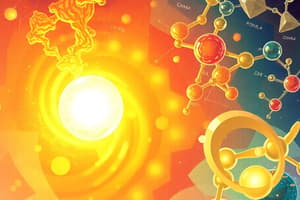Podcast
Questions and Answers
What concept can be applied to estimate quantities in chemistry?
What concept can be applied to estimate quantities in chemistry?
The mole concept.
How can you calculate the molar mass of a compound?
How can you calculate the molar mass of a compound?
Given the name or the formula of the compound.
What can you convert between in stoichiometry?
What can you convert between in stoichiometry?
Particles, mass, and volume.
What is needed to calculate the percent composition of a compound?
What is needed to calculate the percent composition of a compound?
What formulas can you determine based on composition data?
What formulas can you determine based on composition data?
Flashcards are hidden until you start studying
Study Notes
Mole Concept Application
- The mole concept relates chemical quantities to the number of atoms, molecules, or formula units in a substance.
- One mole corresponds to Avogadro's number, approximately (6.022 \times 10^{23}) entities, allowing estimation of quantities in reactions.
Molar Mass Calculation
- Molar mass is determined by summing the atomic masses of all elements in a compound.
- It can be calculated from the chemical formula, where atomic masses can be found on the periodic table.
- Example: The molar mass of water (H₂O) is approximately 18.02 g/mol (2x1.01 for H + 16.00 for O).
Conversion Between Particles, Mass, and Volume
- Use molar mass to convert between mass (grams) and moles:
- (\text{mass (g)} = \text{moles} \times \text{molar mass (g/mol)})
- Use Avogadro's number for conversions between moles and particles:
- (\text{particles} = \text{moles} \times 6.022 \times 10^{23})
- For gases, use the ideal gas law (PV = nRT) to relate moles to volume (L) at standard temperature and pressure (STP).
Percent Composition Calculation
- Percent composition is the mass percent of each element in a compound.
- Calculate percent composition using the formula:
- (\text{Percent composition} = \left( \frac{\text{mass of element in 1 mol of compound}}{\text{molar mass of compound}} \right) \times 100%)
- Example: For CO₂, carbon contributes approximately 27.29%, and oxygen contributes about 72.71%.
Empirical and Molecular Formulas Determination
- The empirical formula represents the simplest whole-number ratio of elements in a compound.
- The molecular formula gives the actual number of atoms of each element in a molecule.
- To find the empirical formula from composition data:
- Convert mass percentages to moles, simplify to the smallest whole number ratio.
- To find the molecular formula:
- Divide the molar mass of the compound by the molar mass of the empirical formula to determine the multiplier.
Studying That Suits You
Use AI to generate personalized quizzes and flashcards to suit your learning preferences.




